I may receive a commission if you purchase through links in this post. I am not a doctor; please consult your practitioner before changing your supplement or healthcare regimen.
Perhaps you’re wondering, 1 tablespoon of honey equals how much sugar? This Exact Conversion Chart of Sugar to Honey When Baking helps you to switch to a healthier way of eating. Bake with ease, using old recipes — but honey in place of sugar!
The first major step many of us take toward wellness is eliminating sugar. In my own health journey, I clung to sugar for as long as I could — lots and lots of ice cream. I had a rash on my face that many of our customers remember. When my skin issue resolved, I got comments occasionally (that made me laugh inside), “I haven’t seen you in so long. Your skin looks so good.” Ha, ha, ha. Apparently my rash was rather noticeable.
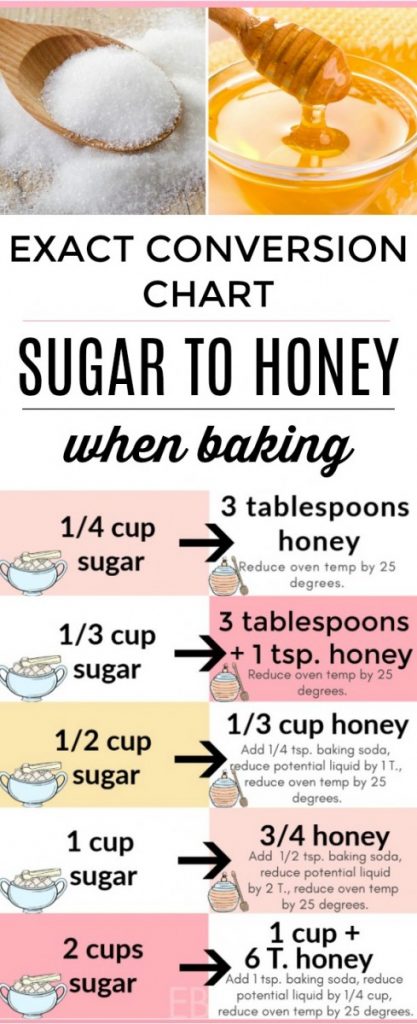
Is sugar bad for you
When I finally released my grip and eliminated sugar, my rash went away immediately. I am sad to think how many people go to dermatologists (and receive pharmaceutical or steroidal topical creams) for skin issues when diet will often heal a variety of rashes (including my daughter’s eczema) — and begin to heal the root cause.
What are the health benefits of cutting out sugar
What else went away immediately upon eliminating sugar from my diet?
Arthritis! It started in my 30s. I’d wake up with my fingers bent and crooked. I couldn’t straighten them, and they were painful to touch.
Although I had this symptom for over a year before giving up sugar, it was completely gone, never to return, upon eliminating sugar.
There were other issues that resolved as well, including candida overgrowth.
Other reported benefits include:
- increased energy
- better mood, clarity and focus
- reversal of all kinds of inflammation issues (including autoimmune disease symptoms, anxiety, brain fog, joint pain, bunion pain, gum disease, puffy skin, allergies, skin issues, digestive problems and more)
- improved weight management
Learn more details here about why white sugar is bad for you.
And use the Exact Conversion Chart of Sugar to Honey to begin making changes when you bake!
What kind of sugar is best
For those who are healthy and symptom-free, sugar is still something to enjoy in moderation. Substituting in whole food alternatives is healthful for everyone.
If you continue to have sugar in your diet, just make sure it’s organic evaporated cane juice or unrefined Sucanat (not white sugar like C&H). These are less refined, more natural forms of sugar and are not genetically modified.
Even healthier options include maple sugar (my personal favorite) and coconut sugar (find at many grocery stores or here).
One way to eliminate, or reduce sugar intake, is to substitute in honey. If you have old favorite recipes you’d like to convert, below are guidelines and a helpful chart!
And here’s How to Convert Any Recipe to Paleo (which means refined sugar-free and grain-free as well).
Exact Conversion Chart of Sugar to Honey
HOW TO SUB HONEY WHEN BAKING
When baking with honey, there are a few characteristics that make it different than baking with sugar.
Here are the 3 main differences:
- Honey browns more quickly in the oven or even in the frying pan (like with pancakes). The solution is baking honey-sweetened batters at a lower temperature.
- Honey is heavier, denser and wetter than sugar. Increasing the quantity of leavening just slightly helps to counteract this.
- Honey is sweeter than sugar AND has a stronger flavor. Decreasing the amount of honey in a recipe that originally called for sugar will prevent your baked good from being too sweet or tasting too strongly of honey, which doesn’t allow other flavors to come through.
Below are the conversions to help you make adjustments. As you’ll notice, there is also the instruction of potentially reducing the liquid in a recipe. This refers to pancake-like recipes that often call for milk. Because honey makes baked goods wetter, it is helpful to reduce milk or other liquid ingredients to compensate.
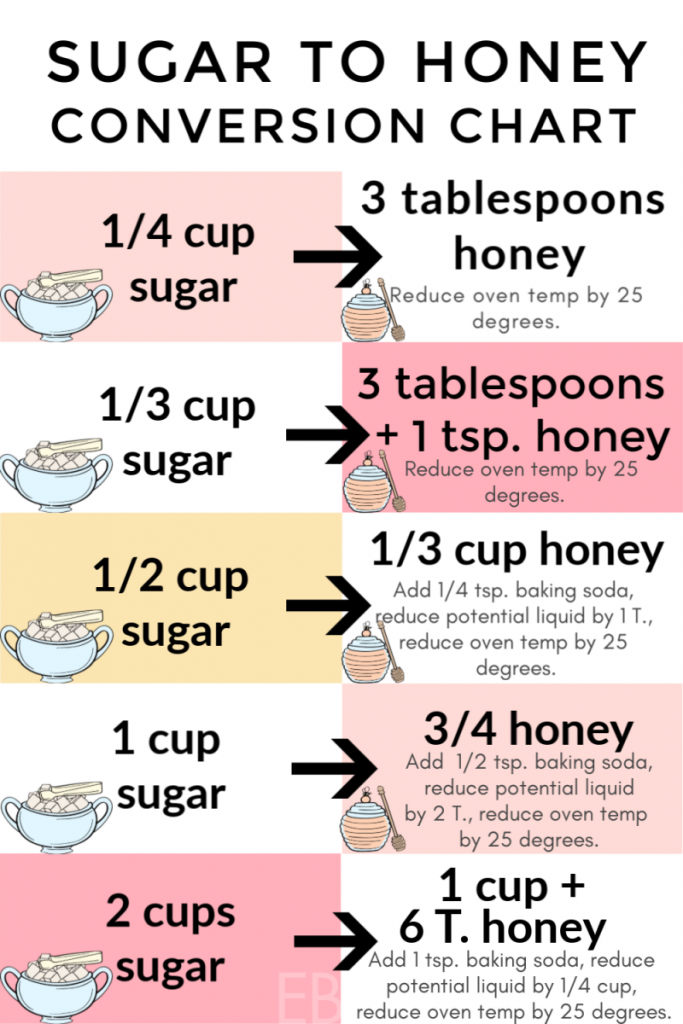
Honey as a substitute for sugar when not baking
Back to a common question that comes up when sweetening liquids or single servings: 1 teaspoon or tablespoon of sugar equals how much honey?
When you’re making liquid recipes like sweet tea or lemonade, how do you convert sugar to honey?
First ask yourself if you want to taste the flavor of honey. If you do, you may substitute honey for sugar 1:1.
If you don’t want to taste the honey as much, but you want it just as sweet, I recommend using one other sweetener in conjunction with honey.
Liquid examples include: liquid stevia drops (for low carb or blood sugar issues), maple syrup, agave syrup and brown rice syrup. Granulated options include: stevia and monk fruit (for low carb or blood sugar issues), maple sugar and coconut sugar.
Other low carb options include erythritol, allulose and xylitol. (But these products cause IBS symptoms for some people.)
If you’re trying to cultivate a taste for foods and drinks that are less sweet, experiment with quantities, based on the size of the overall recipe. For one mug or glass, decrease the sweetener by 1/2 to 1 teaspoon. For a full pitcher of liquid, convert 1/2 cup sugar to 1/4 or 1/3 cup honey, and taste.
Honey as a substitute in small recipes (like mug cakes)
To convert smaller portions of sweetener in baked goods, like individual mug cakes, use slightly more than 3/4 the amount of honey as you would sugar, or decrease by 1 to 2 teaspoons.
So if the recipe calls for 2 Tablespoons of sugar, use 4 to 5 teaspoons of honey, depending on how sweet you want the cake. If you want the cake just as sweet, use 5 teaspoons.
Keep the rest of the recipe the same.
The conversion chart for usual size recipes below is printable! 🙂
EXACT CONVERSION CHART: Sugar –> Honey When Baking!
Equipment
- measuring cups
- measuring spoons
Ingredients
- ¼ cup sugar—> 3 Tablespoons honey
- ⅓ cup sugar—> 3 Tablespoons + 1 teaspoon honey
- ½ cup sugar—> ⅓ cup honey , add ¼ teaspoon baking soda, reduce potential liquid by 1 Tablespoon
- 1 cup sugar—> ¾ cup honey , add ½ teaspoon baking soda, reduce potential liquid by 2 Tablespoons
- 2 cups sugar—> 1 cup + 6 Tablespoons honey , add 1 teaspoon baking soda, reduce potential liquid by ¼ cup
Instructions
- Reduce oven temperature by 25 degrees.
Pin for easy reference Exact Conversion Chart of Sugar to Honey:
Here’s a link to my cookbook and videos. The cookbook is called EAT BEAUTIFUL: Grain-free, Sugar-free and Loving It and has lots of honey-sweetened recipes!
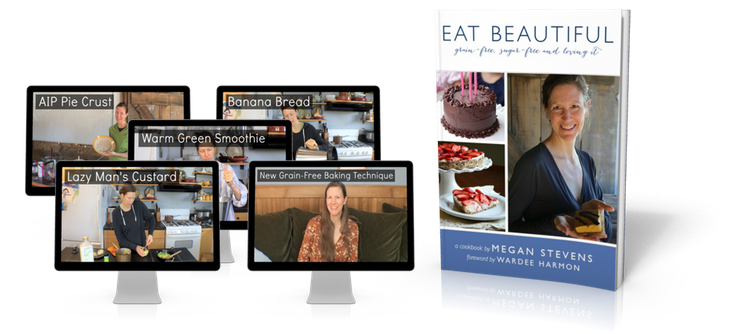
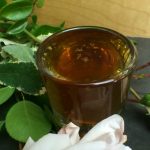
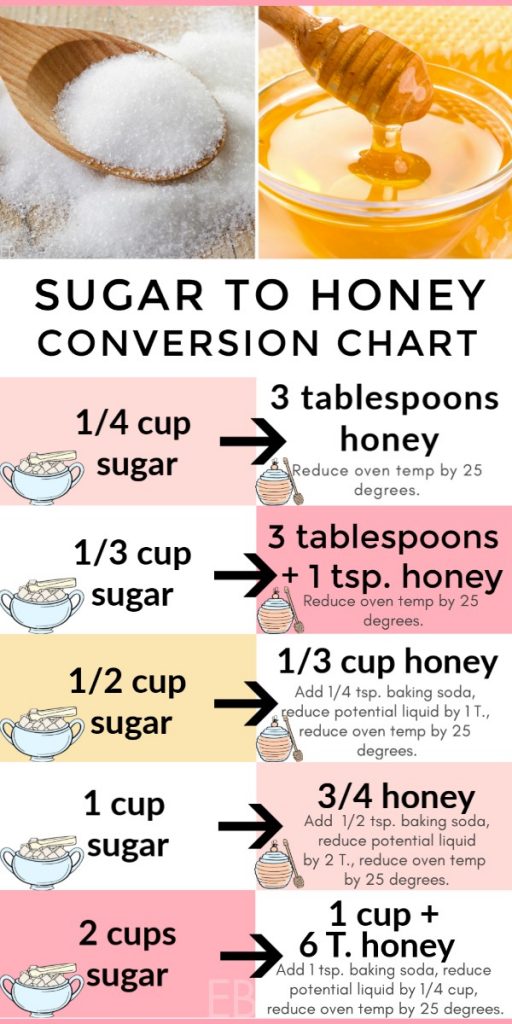

Renee Kohley says
This is so helpful! Thank you!
Megan Stevens says
You are welcome. Thanks for commenting, Renee!
Jessica from SimplyHealthyHome says
I love this. I’m so glad you put it together.
Megan Stevens says
Thank you, Jessica.
Emily @ Recipes to Nourish says
This is SO cool! Thank you for sharing this with us. Super helpful!
Megan Stevens says
You’re welcome, Emily. I’m so glad it’s helpful!
naturalfitfoodie says
Thank you so much for this wonderful resource Megan. Pinning because I know i will need it later.
Megan Stevens says
Great! 🙂
Tash @ HolisticHealthHerbalist says
This is really cool! I would have been WAY off if I was guessing…thanks for this useful tool! 🙂
Megan Stevens says
LOL, I know what you mean! 🙂
Raine Saunders says
This is great, and such an awesome resource for those who are trying to heal from gut dysbiosis. I love that there’s hope for people who are afraid of relinquishing “all sugar” while healing, and that they can still indulge in a well-deserved
treat now and then. Thank you for sharing Megan!
Megan Stevens says
So glad to, Raine. 🙂 I know that for me sweets were essential in the early stages of healing. Honey was my friend! (And still is, but not with the same necessity or intensity.)
The Antidote Life says
This is SO helpful! I have always struggled with getting the right amounts of honey in some of my recipes when I substitute. Definitely won’t be making any horrible honey missteps anymore. 😉
Megan Stevens says
Chuckle… I’m so glad it’s helpful!! 🙂
Rachel says
Pinned this and am bookmarking it too! Such a strugglesaurus when it comes to converting this…
Megan Stevens says
Your comments often make me laugh. Thanks, Rachel. SO true.
Kathleen Ivan says
I rarely use sugar…..I use honey in my tea. I don’t bake a lot, but when I do I’ll consider using honey instead of sugar.
Megan Stevens says
Great, Kathleen! 🙂
Katrina Arbuckle says
Any tips for measuring honey? I love cooking with it, but measuring is always such a messy part.
Bonnie Way Purvis says
Spray whatever measuring utensil that you are using with a little cooking spray before you use it and that will help it to come out easier.
Megan Stevens says
Yes, filling your measuring cup with a preferred oil first (and then pouring the oil back into its original receptacle), and then putting the honey in will allow the honey to come right out when you pour. 🙂
Sarah Nicholas says
Hi I want to make challah bread. What would you suggest I do. The recipe has 5 eggs.
Megan Stevens says
Hi Sarah, you can probably sub in the honey for any sugar in the recipe 1:1. That’s what I’d do. Be aware that the loaf will brown more quickly before the inside is fully cooked. So lower your oven temperature about 1/2-3/4 of the way through baking, when the loaf starts to darken. Also, the honey will possibly make the loaf less stiff. So consider, if needed, chilling the dough before braiding it, so it holds its shape. Good luck!
Beth Ward says
Hello! In addition to GAPS protocol, I follow Ayurvedic medicinal recommendations which includes NOT heating honey past 105° F. Can I use maple syrup in recipes like this one as a substitute for the honey?
Megan Stevens says
Yes, you sure can!
Mr_O says
Refined table sugar is sucrose, which is a disaccharide of glucose and fructose. Your body metabolizes sucrose into its base sugars when it’s consumed. Honey is mostly glucose and fructose, with some maltose (disaccharide of glucose and glucose), some sucrose, and some water content. For nutrition purposes, honey and table sugar are nearly identical.
Kathleen DeRosa says
Is this true? Even with untreated, unheated, totally raw honey?
Mr_O says
Yep, that’s just the chemical formulation of honey. Heat treatment kills any botulism spores that may be in a batch of honey, but it doesn’t change the chemical composition. What’s more, is that since honey is easily digestible, it is quickly metabolized and spikes your blood sugar in much the same way that eating raw table sugar does. In fact, there’s not much difference between eating a tablespoon of honey, and a tablespoon of high-fructose corn syrup.
cindyking839709104 says
The main deal about heating honey is that it destroys all the other benefits of the honey…i.e ..the pollen in the honey…but it still sweetens…& heat does alter the chemical structures of compounds…as far as the changes which occur to the sugars in honey upon heating, I am not 100% sure.
Christine Forker says
It is true they are chemically similar but the GI (glycemic index) numbers are quite different. Honey has a lower GI and therefore does not cause the same spike in blood sugars. The enzymes that the bees put into honey when they are making it ensure that we are able to break down the sugars in our stomach where as refined cane sugar reaches the small intestine before it can be processed and is straight to the blood stream.
Mhathair says
I suffer from thyroid disease and now Hashimoto’s and have to remove gluten and white Foods sugar flour from my diet. We live in the south and we drink sweet tea I usually put two thirds of a cup of sugar ,the kind you mentitled above. I have to give it up and I always have raw local honey in my kitchen. How much honey would be equivalent to the 2/3cup?
Megan Stevens says
Hi and thanks for the great question. In your case, I’d consider putting in a combination of honey and stevia. With thyroid health, cutting back on all sweeteners that affect our blood sugar levels is a good idea. I’d use 1/3-1/2 cup raw honey, and then add stevia, to taste, to get it to the right sweetness overall. This will be better for your hormones, and also not overwhelm your tea with the honey flavor. 🙂
Colleen says
What does reduce by 1/8 cup mean? Do I reduce the batter by 1/8 of a cup?
Megan says
Hi Colleen, any potential liquid in a recipe: So this means if the recipe calls for milk, you would remove 2 tablespoons of the milk. This does not include oil. This rule doesn’t apply to all recipes because all recipes don’t have a liquid included.
Linda Oettli says
I’m making blueberry jam and am concerned about the baking soda bubbling up while the jam is boiling. Do I have to use the baking soda?
Dawn says
As I look at all the blogs and posts and advice on eating clean and taking better care of our family’s nutritional needs, I often think “ok, this is great advice but how?!?!?” I am left wondering how to actually do what the advice says, so reading this and seeing the conversions right here spelled out easily…THANK YOU! Great topic (reducing or eliminating sugar) with the “how to” to go along with it.
Megan says
Hi Dawn, I’m so happy the article is helpful for you, great!! 🙂 Thank you for your comment!
Lynn Clak says
Thank You very helpful
Megan says
You’re welcome, Lynn, I’m so glad! 🙂
Terri says
Wow! The chart is so helpful—especially the notes about adjusting liquid, temp. etc. when substituting honey. ?
Megan says
Great, Terri! Thanks for sharing what’s the most helpful, and I’m so glad!
Blair says
I just picked some wild apples, thinking of making apple jelly – realized there is so much sugar in jams and jellies – decided I might try to use unpasteurized honey ( I have a friend who makes it) and I’m so excited to try honey as a substitute.
Megan says
Hi Blair, honey will behave differently than sugar in a jelly recipe, so let us know how it goes. Usually jellies boil and boil, and this isn’t necessarily recommended for honey, but great that you’re thinking of ways to replace sugar. Jelly might be a good setting to sub maple syrup in instead.
Trisha says
Do you have a good substitute for brown sugar? Or a way to substitute honey and molasses for brown sugar?
Megan says
Hi Trisha, in that situation, I’d sub coconut sugar for the brown sugar. Like this: https://amzn.to/3pE37Dw
Constance Jarman says
Megan. You made my day with the honey conversion chart
Who says a 76 yr. Old nana can’t impress or improve her cooking. Keep it up young one. bon appetite
Nana
Megan says
Oh your sweet comment made my afternoon, how lovely. I’m so glad this is helpful, and thank you for taking the time to leave a sweet message. Blessings, Nana!
Laura says
Hi Megan!
I am making an AIP turkish delight, (juniper honey mint flavor). As the honey is integral due to flavor, I’ll be substituting it for the sugar. For thickening I am using gelatin (and possibly arrowroot), should I still decrease the amount of liquid in this situation?
Megan says
Good question, Laura, no, don’t decrease in that recipe. I hope it turns out, sounds like a fun idea and yummy.